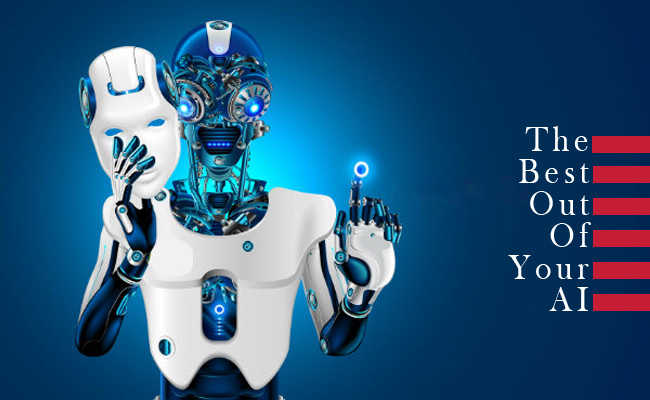How to get the best out of your AI!
By MYBRANDBOOK

The objective of providing right-fit solution options at affordable price points to the customers in the country with the introduction of Artificial Intelligence and Machine Learning have been around for a long time - Digital Assistants based on Artificial Intelligence evolved as an academic discipline in the late 19th century, and has gone through lot of optimism, as well as dejection over the years.
While the earlier ones had limitations by being driven from a static database, the new wave is based on learning new responses and context based on real-time user interactions. The net result is that intelligent voice assistants are now poised to deliver serious applications, a move which may result in a whole new way of interacting with machines, much like what the touchscreens did for smartphones.
Voice Assistants in Consumer areas
You’ve probably already been touched by this - on your mobile phone through Google Assistant, Amazon’s Alexa, Microsoft’s Cortana on your Windows phone (less likely) or Win 10 machine (more likely).
For the uninitiated - picture this – you walk into your house in the evening, ask Alexa the score from today’s cricket match while undoing your tie, followed by getting news highlights sinking into the couch, and ask it to play something soothing while falling flat on your back on your bed. Even pop a myriad question – How old is Richard Nixon today, and how does he get by?
As per a study by Capgemini across 5,000 consumers in the U.S., U.K., France, and Germany, voice assistants will become a dominant way of consumer interaction over the next three years. A quarter of the respondents would rather use a voice assistant than a website. In the next couple of years, this figure will rise to 40%. Additionally, one-thirds would prefer voice assistant interaction rather than visiting a shop or bank branch, compared to 20% today.
Digital voice devices may eclipse smartphones for all activities in the home. These low-cost devices deliver valuable and practical benefits & are easy to use.
Enterprise Virtual Assistants
Consumer-tech & their start-up ecosystem now lead innovation instead of what happens in larger enterprises. As a result - new tech companies in the space are attracting attention - Kasisto, a company that offers a conversational AI platform that’s used by a dozen financial institutions globally, has just received a $17 million Series B funding round.
Previous digital assistants were present on company websites, e.g. Ask Jenn from Alaska Airlines debuted in 2008 or Expedia's virtual customer service agent which launched in 2011. Newer ones include IBM Watson-powered "Rocky", by a Jewelry eCommerce retailer - Rare Carat to assist novice diamond buyers through the daunting process of purchasing a diamond.
What’s involved in the development of a Digital Assistant?
The process of creating a Virtual Chat based assistant or Voice based assistant is similar to the development of a web page or a mobile app. It can be divided into Design, Build and Analytics.
Design
The designer defines the overall interaction and the personality of the bot. This can be viewed as a subset of the conversational design. In order to speed the process, designers make use of dedicated design tools that allow immediate preview, team collaboration and video export.
Build
The process of building a digital assistant has two tasks: understanding user's intent and producing the optimal response. The first works at understanding user input through a Natural Language Processing engine, the second has different approaches depending on the type of the response generated.
Analytics/Training
Digital Assistant usage needs to be monitored to spot errors and to provide useful insights that can refine responses & improve the user experience.
Development Platforms
The development, testing and deployment of Digital Assistants is usually done on cloud based platforms offered by providers such as Google’s API. zAI, Amazon Lex, Microsoft’s LUIS, IBM’s Watson & Wit.ai. These platforms provide Natural Language Processing, Artificial Intelligence and Back-end as a Service for development.
At this juncture, most organizations are experimenting with interactive assistants now on a small scale and this will give interim value, but research suggests that more sophisticated data and machine learning is necessary before they can better understand and even predict what customers need.
The ethical dilemma facing us….
There are some ethical dilemmas on this new frontier of AI going Industrial strength.
Firstly, while we have experimented and used AI before, at this juncture we really seem to be at a point where it can potentially replace a lot of humans in jobs. With the world population reaching 8 billion, and with about 13% of them unemployed - we need more jobs not less.
Secondly, on a purely commercial basis - it may be cheaper to use humans than use the fancy new tech, with the all of the costs associated with early adoption and normalization.
Thirdly, the energy consumption of large scale AI based solutions is a yet unstudied science, and needs a trade-off calculation. We already know blockchain technology is an energy consumption monster. Are we replacing one expense with another?


Legal Battle Over IT Act Intensifies Amid Musk’s India Plans
The outcome of the legal dispute between X Corp and the Indian government c...

Wipro inks 10-year deal with Phoenix Group's ReAssure UK worth
The agreement, executed through Wipro and its 100% subsidiary,...

Centre announces that DPDP Rules nearing Finalisation by April
The government seeks to refine the rules for robust data protection, ensuri...

Home Ministry cracks down on PoS agents in digital arrest scam
Digital arrest scams are a growing cybercrime where victims are coerced or ...


ICONS OF INDIA : ROSHNI NADAR MALHOTRA
Roshni Nadar Malhotra is the Chairperson of HCLTech, a leading global ...

Icons Of India : Anil Kumar Lahoti
Anil Kumar Lahoti, Chairman, Telecom Regulatory Authority of India (TR...

Icons Of India : Deepak Sharma
Deepak Sharma spearheads Schneider Electric India. He brings with him ...


PFC - Power Finance Corporation Ltd
PFC is a leading financial institution in India specializing in power ...

CSC - Common Service Centres
CSC initiative in India is a strategic cornerstone of the Digital Indi...

CERT-IN - Indian Computer Emergency Response Team
CERT-In is a national nodal agency for responding to computer security...


Indian Tech Talent Excelling The Tech World - Sundar Pichai, CEO- Alphabet Inc.
Sundar Pichai, the CEO of Google and its parent company Alphabet Inc.,...

Indian Tech Talent Excelling The Tech World - ANJALI SUD, CEO – Tubi
Anjali Sud, the former CEO of Vimeo, now leads Tubi, Fox Corporation�...

Indian Tech Talent Excelling The Tech World - JAYASHREE ULLAL, President and CEO - Arista Network
Jayshree V. Ullal is a British-American billionaire businesswoman, ser...
 of images belongs to the respective copyright holders
of images belongs to the respective copyright holders